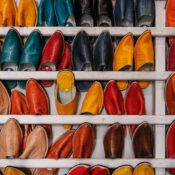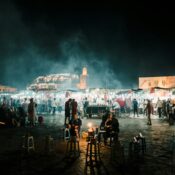
Morocco in December – What to See
Morocco in December: Weather and Climate
Visiting Morocco in December offers a unique blend of mild weather and cultural experiences. The country’s diverse climate zones mean you can experience different weather patterns depending on where you are. Coastal cities like Casablanca and Essaouira enjoy moderate temperatures, often ranging from 12°C to 20°C, while inland cities like Marrakech can be slightly cooler in the evenings. The Atlas Mountains are particularly chilly, often covered in snow, making it a perfect time for mountain trekking and skiing. In the Sahara Desert, daytime temperatures are pleasant, but nights can be quite cold.
To make the most of your trip, it’s important to pack appropriately. Layered clothing is advisable to adjust to the varying temperatures throughout the day. Don’t forget warm clothes for the evenings and early mornings, especially if you plan to visit the mountains or the desert.
Exploring Marrakech
Marrakech is a vibrant city that promises an enchanting blend of history, culture, and modernity. Start your journey at the bustling Jemaa el-Fnaa, the city’s main square, where you can witness a whirlwind of activity, from snake charmers to food stalls. This UNESCO World Heritage site transforms into a lively market at night, offering a sensory overload of sights, sounds, and smells.
A visit to the Majorelle Garden provides a serene escape from the city’s hustle. This botanical garden, once owned by the French painter Jacques Majorelle and later restored by fashion designer Yves Saint Laurent, is a haven of exotic plants and vibrant blue buildings.
Don’t miss the Koutoubia Mosque, the largest mosque in Marrakech, known for its stunning minaret that dominates the city skyline. Although non-Muslims cannot enter the mosque, the surrounding gardens offer a peaceful place to admire its architecture.
Casablanca’s Modern Charm
Casablanca, Morocco’s largest city, is a fascinating blend of modernity and tradition. The Hassan II Mosque, one of the largest mosques in the world, is a must-see. Its magnificent structure extends over the Atlantic Ocean, with a glass floor that allows worshippers to see the sea below. Guided tours are available for non-Muslims, offering insights into its impressive architecture and cultural significance.
The Corniche, a scenic beachfront promenade, is perfect for a leisurely stroll, offering beautiful ocean views and a variety of cafes and restaurants. The Old Medina, although not as famous as those in other Moroccan cities, offers a glimpse into the city’s traditional life with its narrow alleys and local markets.
Historic Fez
Fez, often considered the cultural and spiritual heart of Morocco, is home to the world’s oldest university, Al Quaraouiyine. The city’s medina, a UNESCO World Heritage site, is a labyrinth of narrow streets, ancient mosques, and bustling souks. Exploring Fez Medina feels like stepping back in time, with its well-preserved medieval architecture and vibrant street life.
The Bou Inania Madrasa is another highlight. This 14th-century religious school is known for its stunning tile work, wood carvings, and tranquil courtyard. It’s one of the few religious sites in Morocco open to non-Muslims, offering a glimpse into the country’s rich architectural heritage.
Cultural Riches of Rabat
Rabat, Morocco’s capital, is a city of contrasts, blending historical landmarks with modern developments. The Kasbah of the Udayas, a fortress dating back to the 12th century, offers stunning views of the Atlantic Ocean and the Bou Regreg River. Its narrow, winding streets and white-and-blue houses create a picturesque setting.
Hassan Tower, an incomplete minaret of a mosque that was intended to be the largest in the world, stands as a symbol of Rabat’s historical ambitions. Nearby, the Mausoleum of Mohammed V houses the tombs of the Moroccan king and his sons, featuring exquisite traditional Moroccan craftsmanship.
Chellah, an ancient Roman and medieval fortified city, is another must-visit. This archaeological site offers a fascinating glimpse into Morocco’s past, with its Roman ruins, Islamic burial grounds, and lush gardens.
The Blue City of Chefchaouen
Nestled in the Rif Mountains, Chefchaouen is famous for its striking blue-washed buildings. Wandering through its narrow alleys, you’ll encounter vibrant streetscapes, local artisans, and charming cafes. The blue hue of the buildings, originally intended to ward off mosquitoes, creates a tranquil and visually stunning atmosphere.
The Spanish Mosque, located on a hilltop overlooking the city, offers panoramic views of Chefchaouen and the surrounding mountains. A short hike to this vantage point is well worth the effort, especially during sunset.
Ras El Maa, a serene waterfall on the edge of the city, is a popular spot for both locals and tourists. It’s a great place to relax and enjoy the natural beauty of the area.
Desert Adventures in Merzouga
Merzouga, a small village on the edge of the Sahara Desert, is the gateway to the stunning Erg Chebbi dunes. These towering sand dunes, some as high as 150 meters, provide a dramatic backdrop for desert adventures. Camel treks are a popular way to explore the desert, offering a traditional and immersive experience.
Spending a night in a desert camp under the stars is an unforgettable experience. Many camps offer comfortable accommodations and traditional Berber hospitality, including music and dance performances around the campfire.
For a unique perspective, consider taking a 4×4 tour or sandboarding down the dunes. The desert landscape is ever-changing, providing endless opportunities for exploration and photography.
Mountain Escapes in the Atlas Mountains
The Atlas Mountains offer a stark contrast to Morocco’s bustling cities and arid deserts. Toubkal National Park, home to North Africa’s highest peak, Mount Toubkal, is a paradise for hikers and nature lovers. The trek to the summit is challenging but rewarding, offering breathtaking views of the surrounding landscape.
Berber villages, scattered throughout the mountains, provide a glimpse into the traditional way of life. Many trekking routes pass through these villages, allowing you to experience Berber culture and hospitality firsthand.
The Ouzoud Waterfalls, one of Morocco’s most spectacular natural attractions, are a series of cascading falls set against a backdrop of lush greenery. The area around the falls is ideal for hiking and picnicking, and you might even spot Barbary macaques in the trees.
Seaside Relaxation in Essaouira
Essaouira, a charming coastal city, is known for its laid-back atmosphere and beautiful beaches. The Medina of Essaouira, a UNESCO World Heritage site, is a maze of narrow streets, bustling markets, and historic buildings. The city’s blue and white color scheme, along with its well-preserved ramparts, creates a picturesque setting.
Skala de la Ville, the city’s historic fortress, offers stunning views of the Atlantic Ocean and the harbor. The cannons lining the ramparts add a touch of history to this scenic spot.
Moulay Hassan Square, the main square in Essaouira, is a vibrant hub of activity. It’s surrounded by cafes and restaurants, making it a great place to relax and watch the world go by.
Vibrant Markets and Souks
Morocco’s markets and souks are a treasure trove of local goods, from spices and textiles to pottery and jewelry. Souk El Had in Agadir is one of the largest markets in Morocco, offering a wide variety of products. It’s a great place to shop for souvenirs and experience the local culture.
The Henna Souk in Marrakech is famous for its natural beauty products, including henna, argan oil, and rosewater. It’s a fascinating place to learn about traditional Moroccan cosmetics and remedies.
Fez Leather Souk is renowned for its leather goods, produced using traditional tanning methods. The colorful dye vats are a popular attraction, and you can find everything from bags and shoes to belts and jackets.
Gastronomic Delights of Morocco
Moroccan cuisine is a delightful blend of flavors and influences, reflecting the country’s diverse cultural heritage. Traditional Moroccan dishes such as tagine, couscous, and pastilla are a must-try. These dishes are often flavored with a unique combination of spices, herbs, and ingredients like preserved lemons, olives, and dried fruits.
Conclusion
Morocco in December offers a diverse and enriching travel experience, from the bustling streets of Marrakech to the serene landscapes of the Atlas Mountains and the Sahara Desert. With its rich cultural heritage, stunning natural beauty, and warm hospitality, Morocco is a destination that promises unforgettable memories.




